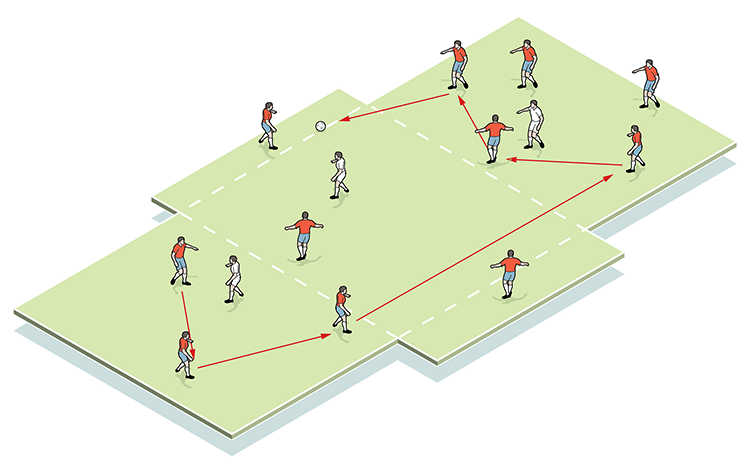Possession and retention
The ability to hold the ball in midfield areas is crucial to any side as gaining control of the midfield often equates to gaining control of the game, so this is a session that should be practised often.

| Area | 40x40 yards with an inner 15v15 square |
| Equipment | Poles, marker discs, balls |
| No. of Players | 16 (7v7 plus two neutral players) |
The fundamental principle of retaining possession occurs in every game. In particular, the ability to hold the ball in midfield areas is crucial to any side, with an eye on good movement and fluid rotation from forward and wide players. Gaining control of the midfield often equates to gaining control of the game, so this is a session that will we practise often.
What do I get the players to do?
We play 7v7 in the large square, with a pole positioned centrally along each long touchline. Two players from each team are fixed to poles opposite one another. These players can only be released when brought into play by a team-mate, who must pass the ball to him and take his place on the pole (1a).
1a

The team in possession can use the two neutral players (who must always remain in the small square) for overload advantage, therefore creating a 9v7 game (1b).
1b

The result is a passing and possession game between fixed and mobile team-mates (1c). Should the ball go out of play or possession be turned over, the other team restarts and can now utilise the two neutral players.
1c

What are the key things to look for technically/tactically?
This is a session that requires quality passing, intelligent decision-making and excellent movement and rotation. Players must adopt good passing angles, clever timing and strong positional awareness. Holding onto possession and being willing to free a fixed man are the main aims of the session.
How do I progress the session?
We progress by creating a scenario that rehearses players in gaining control of the game specifically in midfield areas. We use 14 players in a 60x30 yard playing area - the longer side split into three 20 yard zones. On each side of the central zone is an area extended 5 yards outwards. The overloads are 5v1 in the far zone, 3v1 in the middle section (with two attackers fixed wide) and 3v1 in the near zone (2a).
2a

In the 3v1 near zone, an attacking player starts with the ball. A minimum of two passes are made before a long ball is played into the far zone. At least two passes are made before a pass to either of the wide players in the central 3v1 zone. Receiving a pass frees both wide players (2b). Two of those in the middle now head to the near zone to create a new 5v1 overload. Two attackers from the far zone move into the middle zone to occupy the now vacant wide areas. Play can now be played back in the other direction (2c).
2b

2c

The key area is the middle third, yet players are using both end zones to launch midfield player exchanges, a weapon that can be utilised to great effect in matchday situations.
Editor's Picks
Attacking transitions
Deep runs in the final third
Using the goalkeeper in build-up play
Intensive boxes drill with goals
Penetrating the final third
Creating and finishing
My philosophy
Pressing initiation
Compact team movement
Coaches' Testimonials

Alan Pardew

Arsène Wenger

Brendan Rodgers

Carlos Carvalhal

José Mourinho

Jürgen Klopp

Pep Guardiola

Roy Hodgson

Sir Alex Ferguson

Steven Gerrard
Coaches' Testimonials

Gerald Kearney, Downtown Las Vegas Soccer Club

Paul Butler, Florida, USA

Rick Shields, Springboro, USA

Tony Green, Pierrefonds Titans, Quebec, Canada
Join the world's leading coaches and managers and discover for yourself one of the best kept secrets in coaching. No other training tool on the planet is written or read by the calibre of names you’ll find in Elite Soccer.
In a recent survey 92% of subscribers said Elite Soccer makes them more confident, 89% said it makes them a more effective coach and 91% said it makes them more inspired.
Get Monthly Inspiration
All the latest techniques and approaches
Since 2010 Elite Soccer has given subscribers exclusive insight into the training ground practices of the world’s best coaches. Published in partnership with the League Managers Association we have unparalleled access to the leading lights in the English leagues, as well as a host of international managers.
Elite Soccer exclusively features sessions written by the coaches themselves. There are no observed sessions and no sessions “in the style of”, just first-hand advice delivered direct to you from the coach.









